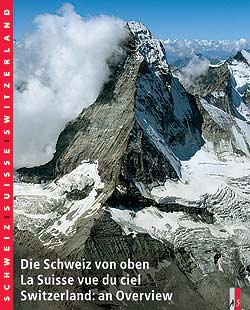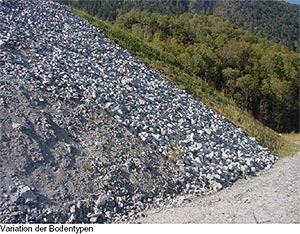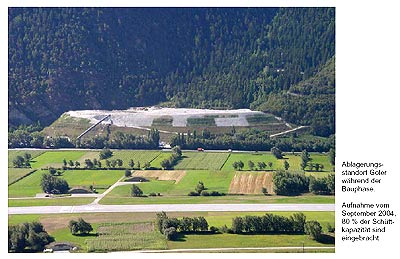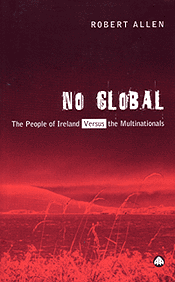Switzerland: an Overview
 by Emil Zopfi et al
by Emil Zopfi et al
review by Robert Allen
|
The people of Switzerland, if we believe their
pronouncements that the country doesn't exist anymore, are
having a genuine crisis about their identity and
specifically about their sense of place.
|
 Martin, an ageing chef who works in a family restaurant in
Naters, a river village on the northern side of the Rhone
in the Valais/Wallis (valley) canton, insists that the
unique sense of place Swiss people share with their
mountains and valleys is dying out, destroyed by modernity
and technology.
However another Martin, one of the young project managers
who works at the construction of a 34.6 kilometre railway
tunnel through the base of the Alps between Raron in the
Valais/Wallis canton and Frutigen in the canton of Berne,
takes a sense of pride in the creation of this human-built
artefact.
Functionality is a byword of modern Switzerland. It defines
the daily activity of a country that runs to precise
timetables and delivers its workers and visitors to their
destinations on time, whether by bus, train, funicular,
cablecar, boat or airplane. The workers then deliver a
commerce that the people expect, in their offices, schools,
factories, farms, shops, restaurants and construction
sites. "Switzerland," says Benedikt Loderer, "is fully
utilised."
The relationship between the human-built world and natural
world is the theme of this book, a collection of five
essays, which look at these two Switzerlands - Beauty
Switzerland and Utility Switzerland. What makes the book
breathtaking along with its literary scope are the majestic
aerial photographs, which accompany the essays, placing
them in a context that cannot refute the perspectives of
the essayists.
Loderer is the most persuasive with his argument that
Switzerland no longer exists. "The beautiful Switzerland
you see is the pre-industrial one," he says. "Within two
generations we have consumed too much of Switzerland. [It]
is fully utilised. We know precisely what every bit of it
can be used for, whether it's a lake, a glacier, a cliff,
arable or maintained land. This also means that it's
already been decided what the land may not be used for. The
main difference is that of construction zones and
non-construction zones."
The Valais/Wallis canton in the south-west of the country
is precisely that. The human-built construction zone at the
Raron end of the Lötschberg base tunnel contrasts starkly
with the natural mountain peaks above, and the creation of
an artificial mound containing the tunnel deposits at the
southern edge of the Rhone valley flood plain. The
relocation - on the orders of the federal government, which
commissioned the tunnel - of wildlife disturbed by the
construction reveals the sensitive nature of 'nachhaltig'
(sustainable development) in Switzerland.
This is also Loderer's argument. "Beauty Switzerland is a
recompense for Utility Switzerland," he says.
"There are two conditions left in the country; the city and
the mountains. We've become tourists in our own country. We
commute from Utility to Beauty Switzerland in order to
consolidate our identity there. Being convinced of the
beauty of the country in our innermost being, we must get
out of the agglomeration from time to time and refresh
ourselves with a landscape and a picturesque settlement.
There are two directions: into the old inner cities or into
the mountains. It depends on the type of nourishment we
lack. In the old inner city there is more cultural
enjoyment; in the mountains, it's more the enjoyment of
Nature. And there is a sufficient number of rewarding
destinations for both directions. This book proves it."
Martin, an ageing chef who works in a family restaurant in
Naters, a river village on the northern side of the Rhone
in the Valais/Wallis (valley) canton, insists that the
unique sense of place Swiss people share with their
mountains and valleys is dying out, destroyed by modernity
and technology.
However another Martin, one of the young project managers
who works at the construction of a 34.6 kilometre railway
tunnel through the base of the Alps between Raron in the
Valais/Wallis canton and Frutigen in the canton of Berne,
takes a sense of pride in the creation of this human-built
artefact.
Functionality is a byword of modern Switzerland. It defines
the daily activity of a country that runs to precise
timetables and delivers its workers and visitors to their
destinations on time, whether by bus, train, funicular,
cablecar, boat or airplane. The workers then deliver a
commerce that the people expect, in their offices, schools,
factories, farms, shops, restaurants and construction
sites. "Switzerland," says Benedikt Loderer, "is fully
utilised."
The relationship between the human-built world and natural
world is the theme of this book, a collection of five
essays, which look at these two Switzerlands - Beauty
Switzerland and Utility Switzerland. What makes the book
breathtaking along with its literary scope are the majestic
aerial photographs, which accompany the essays, placing
them in a context that cannot refute the perspectives of
the essayists.
Loderer is the most persuasive with his argument that
Switzerland no longer exists. "The beautiful Switzerland
you see is the pre-industrial one," he says. "Within two
generations we have consumed too much of Switzerland. [It]
is fully utilised. We know precisely what every bit of it
can be used for, whether it's a lake, a glacier, a cliff,
arable or maintained land. This also means that it's
already been decided what the land may not be used for. The
main difference is that of construction zones and
non-construction zones."
The Valais/Wallis canton in the south-west of the country
is precisely that. The human-built construction zone at the
Raron end of the Lötschberg base tunnel contrasts starkly
with the natural mountain peaks above, and the creation of
an artificial mound containing the tunnel deposits at the
southern edge of the Rhone valley flood plain. The
relocation - on the orders of the federal government, which
commissioned the tunnel - of wildlife disturbed by the
construction reveals the sensitive nature of 'nachhaltig'
(sustainable development) in Switzerland.
This is also Loderer's argument. "Beauty Switzerland is a
recompense for Utility Switzerland," he says.
"There are two conditions left in the country; the city and
the mountains. We've become tourists in our own country. We
commute from Utility to Beauty Switzerland in order to
consolidate our identity there. Being convinced of the
beauty of the country in our innermost being, we must get
out of the agglomeration from time to time and refresh
ourselves with a landscape and a picturesque settlement.
There are two directions: into the old inner cities or into
the mountains. It depends on the type of nourishment we
lack. In the old inner city there is more cultural
enjoyment; in the mountains, it's more the enjoyment of
Nature. And there is a sufficient number of rewarding
destinations for both directions. This book proves it."
 Loderer apologises for his cynicism. And he must. This book
is an honest appraisal of modern Switzerland and the
pictures do prove that Switzerland is still beautiful and
rewarding, one of the most attractive countries in Europe.
The Switzerland of pristine alpine and lakeside resorts,
modern funparks and elaborate transport systems offers as
much to the visitor as the Switzerland of precipitous
mountain paths, old restaurants and traditional festivals.
The photographs - from the 'photoswissair' collection of
the Luftbild Schweiz Foundation, started by Walter
Mittelholzer, the Swiss pioneer aviator and photographer
who began taking aerial pictures in 1918 - show both
Switzerlands. They reveal, in glimpses, the Switzerland of
the pre-industrial era and the modern Switzerland that
contradicts its romantic caricature. Unlike Italy, which is
suffocating under the weight of tourist expectation,
Switzerland has been allowed to reinvent itself, for good
or bad.
More than Frenchman Yann Arthus-Bertrand's stunning but
selective aerial pictures of human settlements in every
region of the Earth, the Luftbild Schweiz photographs
reveal an intimacy that only those who live in Switzerland
and know every centimetre will fully appreciate. As an
overview of a country this book is a perfect portal.
From the pictures of the Matterhorn, as if civilisation
never existed, to the pictures of the Rhone glacier, where
civilisation in the form of a switchback road and a hotel
creeps up to the edge of the ice, Switzerland is at once
untamed and tamed, a point made by Iso Camartin in his
introduction to the book. "It is not even the boldness with
which human beings have made changes in the landscape,
opposing the natural-growth and nature-given beauty with
another one: that of beautiful design and daring
construction."
Martin, in his tunnel, would agree that daring construction
now defines Switzerland. Martin, in his kitchen, would not.
For him Switzerland is and always will be the mountains.
Iso Camartin, however, knows the real truth. "What are we
complaining about?" he says. "It's great to live here."
Loderer apologises for his cynicism. And he must. This book
is an honest appraisal of modern Switzerland and the
pictures do prove that Switzerland is still beautiful and
rewarding, one of the most attractive countries in Europe.
The Switzerland of pristine alpine and lakeside resorts,
modern funparks and elaborate transport systems offers as
much to the visitor as the Switzerland of precipitous
mountain paths, old restaurants and traditional festivals.
The photographs - from the 'photoswissair' collection of
the Luftbild Schweiz Foundation, started by Walter
Mittelholzer, the Swiss pioneer aviator and photographer
who began taking aerial pictures in 1918 - show both
Switzerlands. They reveal, in glimpses, the Switzerland of
the pre-industrial era and the modern Switzerland that
contradicts its romantic caricature. Unlike Italy, which is
suffocating under the weight of tourist expectation,
Switzerland has been allowed to reinvent itself, for good
or bad.
More than Frenchman Yann Arthus-Bertrand's stunning but
selective aerial pictures of human settlements in every
region of the Earth, the Luftbild Schweiz photographs
reveal an intimacy that only those who live in Switzerland
and know every centimetre will fully appreciate. As an
overview of a country this book is a perfect portal.
From the pictures of the Matterhorn, as if civilisation
never existed, to the pictures of the Rhone glacier, where
civilisation in the form of a switchback road and a hotel
creeps up to the edge of the ice, Switzerland is at once
untamed and tamed, a point made by Iso Camartin in his
introduction to the book. "It is not even the boldness with
which human beings have made changes in the landscape,
opposing the natural-growth and nature-given beauty with
another one: that of beautiful design and daring
construction."
Martin, in his tunnel, would agree that daring construction
now defines Switzerland. Martin, in his kitchen, would not.
For him Switzerland is and always will be the mountains.
Iso Camartin, however, knows the real truth. "What are we
complaining about?" he says. "It's great to live here."
-
–
Review by Robert Allen
 Die Schweiz von oben / La Suisse vue du ciel / Switzerland: an Overview, by Emil Zopfi et al, AS Verlag, sfr88 ($75/€58/£40)
AS Verlag http://www.as-verlag.ch
Die Schweiz von oben / La Suisse vue du ciel / Switzerland: an Overview, by Emil Zopfi et al, AS Verlag, sfr88 ($75/€58/£40)
AS Verlag http://www.as-verlag.ch
Luftbild Schweiz Foundation http://www.luftbild.ch
 Robert Allen is the author of Dioxin War: Truth & Lies About A Perfect Poison, Pluto Press, London/Ann Arbor/Dublin and University of Michigan, US, published in July 2004. Amazon.co.uk, Amazon.com.
Book Description
This is a book about Dioxin, one of the most poisonous chemicals known to humanity. It was the toxic component of Agent Orange, used by the US military to defoliate huge tracts of Vietnam during the war in the 60s and 70s.
It can be found in pesticides, plastics, solvents, detergents and cosmetics. Dioxin has been revealed as a human carcinogen, and has been associated with heart disease, liver damage, hormonal disruption, reproductive disorders, developmental destruction and neurological impairment.
The Dioxin War is the story of the people who fought to reveal the truth about dioxin. Huge multinationals Dow and Monsanto both manufactured Agent Orange. Robert Allen reveals the attempts by the chemical industry, in collusion with regulatory and health authorities, to cover up the true impact of dioxin on human health. He tells the remarkable story of how a small, dedicated group of people managed to bring the truth about dioxin into the public domain and into the courts - and win.
Robert Allen is the author of Dioxin War: Truth & Lies About A Perfect Poison, Pluto Press, London/Ann Arbor/Dublin and University of Michigan, US, published in July 2004. Amazon.co.uk, Amazon.com.
Book Description
This is a book about Dioxin, one of the most poisonous chemicals known to humanity. It was the toxic component of Agent Orange, used by the US military to defoliate huge tracts of Vietnam during the war in the 60s and 70s.
It can be found in pesticides, plastics, solvents, detergents and cosmetics. Dioxin has been revealed as a human carcinogen, and has been associated with heart disease, liver damage, hormonal disruption, reproductive disorders, developmental destruction and neurological impairment.
The Dioxin War is the story of the people who fought to reveal the truth about dioxin. Huge multinationals Dow and Monsanto both manufactured Agent Orange. Robert Allen reveals the attempts by the chemical industry, in collusion with regulatory and health authorities, to cover up the true impact of dioxin on human health. He tells the remarkable story of how a small, dedicated group of people managed to bring the truth about dioxin into the public domain and into the courts - and win.
 Robert Allen is the author of No Global: The People of Ireland versus the Multinationals, Pluto Press, London/Ann Arbor/Dublin, published in April 2004. Amazon.co.uk, Amazon.com.
Book Description
Ireland's economy has seen phenomenal growth since the 1990s, as a result of an earlier decision by the state to chase foreign investment, largely from US corporates. As a result, manufacturers of raw chemicals, pharmaceuticals and highly dangerous substances came to Ireland, where they could make toxic products free from the strict controls imposed by other nations.
Robert Allen's book reveals the consequences to human health and the environment of the Irish state's love affair with the multinational chemical industry. The cost to Irish society was a series of ecological and social outrages, starting in the 1970s and continuing into the 2000s.
No Global is a lesson for countries who seek to encourage multinationals at the expense of the health their population and the delicate nature of their ecosystems. It is also a heart-warming record of the successful campaigns fought by local people to protect themselves and their environment from polluting industry
Robert Allen is the author of No Global: The People of Ireland versus the Multinationals, Pluto Press, London/Ann Arbor/Dublin, published in April 2004. Amazon.co.uk, Amazon.com.
Book Description
Ireland's economy has seen phenomenal growth since the 1990s, as a result of an earlier decision by the state to chase foreign investment, largely from US corporates. As a result, manufacturers of raw chemicals, pharmaceuticals and highly dangerous substances came to Ireland, where they could make toxic products free from the strict controls imposed by other nations.
Robert Allen's book reveals the consequences to human health and the environment of the Irish state's love affair with the multinational chemical industry. The cost to Irish society was a series of ecological and social outrages, starting in the 1970s and continuing into the 2000s.
No Global is a lesson for countries who seek to encourage multinationals at the expense of the health their population and the delicate nature of their ecosystems. It is also a heart-warming record of the successful campaigns fought by local people to protect themselves and their environment from polluting industry
|
|
 by Emil Zopfi et al
by Emil Zopfi et al Martin, an ageing chef who works in a family restaurant in
Naters, a river village on the northern side of the Rhone
in the Valais/Wallis (valley) canton, insists that the
unique sense of place Swiss people share with their
mountains and valleys is dying out, destroyed by modernity
and technology.
However another Martin, one of the young project managers
who works at the construction of a 34.6 kilometre railway
tunnel through the base of the Alps between Raron in the
Valais/Wallis canton and Frutigen in the canton of Berne,
takes a sense of pride in the creation of this human-built
artefact.
Functionality is a byword of modern Switzerland. It defines
the daily activity of a country that runs to precise
timetables and delivers its workers and visitors to their
destinations on time, whether by bus, train, funicular,
cablecar, boat or airplane. The workers then deliver a
commerce that the people expect, in their offices, schools,
factories, farms, shops, restaurants and construction
sites. "Switzerland," says Benedikt Loderer, "is fully
utilised."
The relationship between the human-built world and natural
world is the theme of this book, a collection of five
essays, which look at these two Switzerlands - Beauty
Switzerland and Utility Switzerland. What makes the book
breathtaking along with its literary scope are the majestic
aerial photographs, which accompany the essays, placing
them in a context that cannot refute the perspectives of
the essayists.
Loderer is the most persuasive with his argument that
Switzerland no longer exists. "The beautiful Switzerland
you see is the pre-industrial one," he says. "Within two
generations we have consumed too much of Switzerland. [It]
is fully utilised. We know precisely what every bit of it
can be used for, whether it's a lake, a glacier, a cliff,
arable or maintained land. This also means that it's
already been decided what the land may not be used for. The
main difference is that of construction zones and
non-construction zones."
The Valais/Wallis canton in the south-west of the country
is precisely that. The human-built construction zone at the
Raron end of the Lötschberg base tunnel contrasts starkly
with the natural mountain peaks above, and the creation of
an artificial mound containing the tunnel deposits at the
southern edge of the Rhone valley flood plain. The
relocation - on the orders of the federal government, which
commissioned the tunnel - of wildlife disturbed by the
construction reveals the sensitive nature of 'nachhaltig'
(sustainable development) in Switzerland.
This is also Loderer's argument. "Beauty Switzerland is a
recompense for Utility Switzerland," he says.
"There are two conditions left in the country; the city and
the mountains. We've become tourists in our own country. We
commute from Utility to Beauty Switzerland in order to
consolidate our identity there. Being convinced of the
beauty of the country in our innermost being, we must get
out of the agglomeration from time to time and refresh
ourselves with a landscape and a picturesque settlement.
There are two directions: into the old inner cities or into
the mountains. It depends on the type of nourishment we
lack. In the old inner city there is more cultural
enjoyment; in the mountains, it's more the enjoyment of
Nature. And there is a sufficient number of rewarding
destinations for both directions. This book proves it."
Martin, an ageing chef who works in a family restaurant in
Naters, a river village on the northern side of the Rhone
in the Valais/Wallis (valley) canton, insists that the
unique sense of place Swiss people share with their
mountains and valleys is dying out, destroyed by modernity
and technology.
However another Martin, one of the young project managers
who works at the construction of a 34.6 kilometre railway
tunnel through the base of the Alps between Raron in the
Valais/Wallis canton and Frutigen in the canton of Berne,
takes a sense of pride in the creation of this human-built
artefact.
Functionality is a byword of modern Switzerland. It defines
the daily activity of a country that runs to precise
timetables and delivers its workers and visitors to their
destinations on time, whether by bus, train, funicular,
cablecar, boat or airplane. The workers then deliver a
commerce that the people expect, in their offices, schools,
factories, farms, shops, restaurants and construction
sites. "Switzerland," says Benedikt Loderer, "is fully
utilised."
The relationship between the human-built world and natural
world is the theme of this book, a collection of five
essays, which look at these two Switzerlands - Beauty
Switzerland and Utility Switzerland. What makes the book
breathtaking along with its literary scope are the majestic
aerial photographs, which accompany the essays, placing
them in a context that cannot refute the perspectives of
the essayists.
Loderer is the most persuasive with his argument that
Switzerland no longer exists. "The beautiful Switzerland
you see is the pre-industrial one," he says. "Within two
generations we have consumed too much of Switzerland. [It]
is fully utilised. We know precisely what every bit of it
can be used for, whether it's a lake, a glacier, a cliff,
arable or maintained land. This also means that it's
already been decided what the land may not be used for. The
main difference is that of construction zones and
non-construction zones."
The Valais/Wallis canton in the south-west of the country
is precisely that. The human-built construction zone at the
Raron end of the Lötschberg base tunnel contrasts starkly
with the natural mountain peaks above, and the creation of
an artificial mound containing the tunnel deposits at the
southern edge of the Rhone valley flood plain. The
relocation - on the orders of the federal government, which
commissioned the tunnel - of wildlife disturbed by the
construction reveals the sensitive nature of 'nachhaltig'
(sustainable development) in Switzerland.
This is also Loderer's argument. "Beauty Switzerland is a
recompense for Utility Switzerland," he says.
"There are two conditions left in the country; the city and
the mountains. We've become tourists in our own country. We
commute from Utility to Beauty Switzerland in order to
consolidate our identity there. Being convinced of the
beauty of the country in our innermost being, we must get
out of the agglomeration from time to time and refresh
ourselves with a landscape and a picturesque settlement.
There are two directions: into the old inner cities or into
the mountains. It depends on the type of nourishment we
lack. In the old inner city there is more cultural
enjoyment; in the mountains, it's more the enjoyment of
Nature. And there is a sufficient number of rewarding
destinations for both directions. This book proves it."



 Robert Allen is the author of Dioxin War: Truth & Lies About A Perfect Poison, Pluto Press, London/Ann Arbor/Dublin and
Robert Allen is the author of Dioxin War: Truth & Lies About A Perfect Poison, Pluto Press, London/Ann Arbor/Dublin and  Robert Allen is the author of No Global: The People of Ireland versus the Multinationals, Pluto Press, London/Ann Arbor/Dublin, published in April 2004.
Robert Allen is the author of No Global: The People of Ireland versus the Multinationals, Pluto Press, London/Ann Arbor/Dublin, published in April 2004.